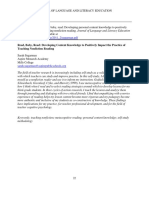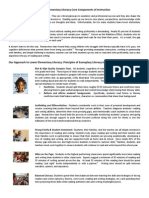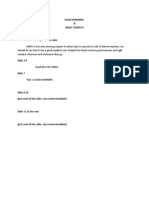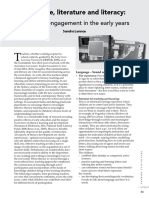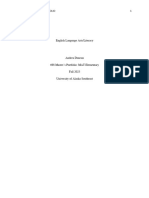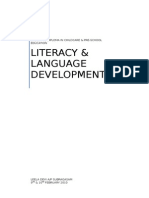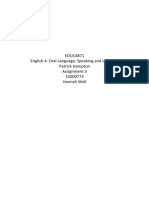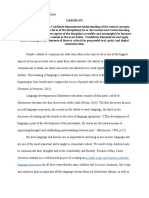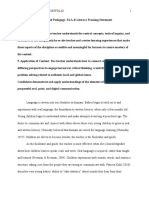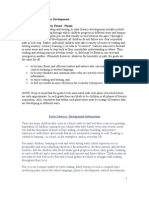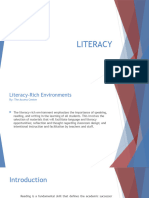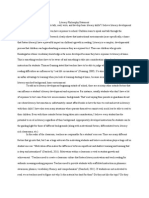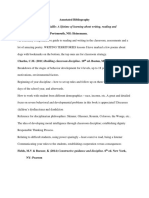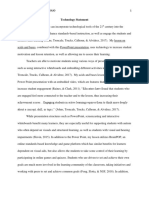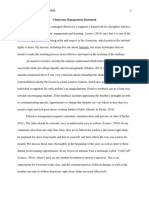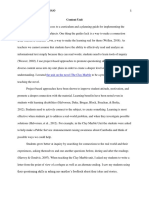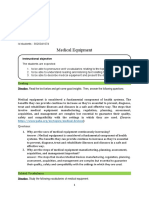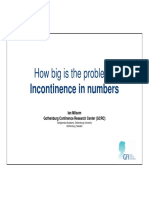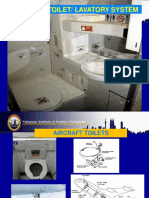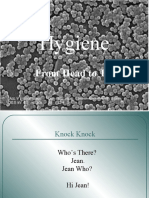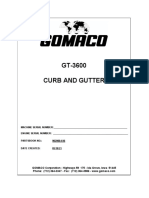ANASTASIA ANISIMOVA’S MASTERS PORTFOLIO
Development Statement
Children are not only unique as individuals but also as learners; since they come from
many different homes, by the time they enter a school some may have already been exposed to a
wide range of literature, while others may not receive any support until they begin their formal
schooling (Neuman, 2019). As an educator, my responsibility is to ensure that all students can
reach developmentally appropriate goals not only in literacy, but also in social-emotional
learning.
Excitement is the key to fostering a child’s development skills. Just as there are optimal
conditions for a body to build muscle, children also learn more successfully under certain
conditions. While there are quite a few possible conditions, such as immersion, demonstration,
engagement, (having) expectations, employment (application), and response (feedback), in my
mind one of the most important conditions is approximation, or the use of language before it’s
fully developed (Cambourne, 1995). This is similar to when babies start to make noises to
approximate language, and the parents are joyous at their attempts; the child’s emerging literacy,
and the attempts at reading and writing must be received with praise and joy, because eventually
the child’s immature forms will be replaced by conventional ones (Cambourne, 1995). This
sample of emergent writing shows how children begin to attempt to communicate in their use of
writing symbols; the development of an idea will come before the development of the syntax and
grammar, and the students’ work is telling of their engagement in the experience of writing.
These students’ attempts at writing were received by me with praise and requests for more,
encouraging them to keep practicing.
Oral language and literacy develop together (Strickland, Morrow, Neuman, Roskos,
Schickedanz, & Vukelich, 2004). Children’s use of rhymes and chants in games creates
�ANASTASIA ANISIMOVA’S MASTERS PORTFOLIO
phonological awareness and is a great predictor of literacy development. Literacy skills are often
initially modeled at home; everything that adults say, read, or write is observed by the child, and
serves to model the use of literacy skills; this in turn inspires the child to apply their own
knowledge, which is the most powerful way to secure new learning (Strickland, et. Al., 2004). In
the sample of emergent writing you can see the students attempt to explain things they are
currently working with or learning; the recipe for French toast serves as a perfect example of the
child attempting a task they have seen completed by a grown-up, and is inspiring in it’s
connection to real-life tasks. In addition, parents who read to their children support their growing
schemas about how stories are told, and expose them to print, fostering future understanding
(Newman, 2019). In my classroom I have a daily read-aloud to support exposure to new
vocabulary and comprehension skills; we have a partner pair and read, or small group reading,
where students model and support one another’s fluency; finally, I do a “read to your toy”
Friday, where students can read their favorite books to their fluffy friends, and everyone can
experience the joy of being the better reader.
Students best retain information when they engage in social aspects of learning to use
critical thinking to engage with one another, debate and shift perspectives, and form unique
opinions (Johnston, 2012). In my classroom students often review one another’s writing and give
helpful suggestions as to how to become better writers; this feedback is often viewed as support
by their peers, and much better received than that which is given by the teacher.
I use socialization and play time in my classroom to support learning. As children play
together they use their imagination and develop problem solving skills to work out solutions and
create stories (Pyle, Prioletta, Poliszczuk, 2018). For example, when children write stories about
their life, as in the sample above when the student is discussing wanting a dog, I invite the
�ANASTASIA ANISIMOVA’S MASTERS PORTFOLIO
students to share their stories with one another; this increases engagement, and promotes
developing social skills, as well as just plain fun. When I have small reading groups of students
who are doing read-aloud theatre the room is filled with laughter and joy of play, yet the students
are reading one another’s parts to follow along and building fluency as well as impulse control
and social skills. Guided play in the classroom can engage more students in application of
knowledge and can be used to support instruction in the essential academic elements. The
conversations that take place among students during guided play can be used to assess their
comprehension (Taylor & Nolen, 2008).
One of the major goals in creating literacy is to foster independence in the child as a
reader, a question asker, and learner (Girling-Butcher, Philips, & Clay, 1991). When my students
share their writing with one another, such as the emergent writing samples shown above, they
become one another’s editors, critics, and teachers; most importantly, they take learning into
their own hands. Self-efficacy in students allows me as a teacher to differentiate among my
students, and better address various needs of my class, as well as to prepare them to be better
citizens of the world.
References
Cambourne, B. (1995). Toward an educationally relevant theory of literacy learning: twenty
years of inquiry. Reading Teacher, 49, 182–190. https://doi-
org.ezproxy.uas.alaska.edu/10.1598/RT.49.3.1
Girling-Butcher, W., Phillips, G., Clay, M. M. (1991). Fostering independent learning. Reading
Teacher, 44, 694–697. Retrieved from
http://search.ebscohost.com.ezproxy.uas.alaska.edu/login.aspx?direct=true&db=eft&AN
=508352840&login.asp&site=ehost-live
�ANASTASIA ANISIMOVA’S MASTERS PORTFOLIO
Johnston, P. (2012). Opening Minds: Using Language to Change Lives. Portland, ME: Stenhouse
Neuman, S. B. (2019). First Steps toward Literacy: What Effective Pre-K Instruction Looks
Like. American Educator, 42(4), 9–11. Retrieved from
http://search.ebscohost.com.ezproxy.uas.alaska.edu/login.aspx?direct=true&db=eric&AN
=EJ1200519&login.asp&site=ehost-live
Pyle, A., Prioletta, J., Poliszczuk, D. (2018). The Play-Literacy Interface in Full-day
Kindergarten Classrooms. Early Childhood Education Journal, 46(1), 117–127.
https://doi-org.ezproxy.uas.alaska.edu/10.1007/s10643-017-0852-z
Strickland, D. S., Morrow, L. M., Neuman, S. B., Roskos, K., Schickedanz, J. A., & Vukelich, C.
(2004). The Role of Literacy in Early Childhood Education. Reading Teacher, 58(1), 86–
100. Retrieved from
http://search.ebscohost.com.ezproxy.uas.alaska.edu/login.aspx?direct=true&db=eric&AN
=EJ684373&login.asp&site=ehost-live
Taylor, C.S., Nolen, S.B. (2008). Classroom Assessment: Supporting Teaching and Learning in
Real classrooms (2nd ed.) Columbus, OH : Pearson






